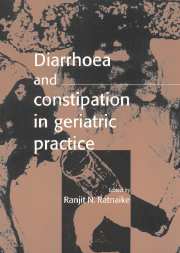Book contents
- Frontmatter
- Contents
- List of contributors
- Preface
- Acknowledgments
- Foreword by Gary R. Andrews
- I Defences of the aging gastrointestinal tract
- II Diarrhoea
- III Noninfectious clinical entities
- 11 Coeliac disease
- 12 Inflammatory disorders of the colon
- 13 Neoplasia and diarrhoea
- 14 Irritable bowel syndrome
- 15 Endocrine, metabolic and miscellaneous causes of diarrhoea
- IV Constipation
- V Perspectives of altered bowel function
- Index
15 - Endocrine, metabolic and miscellaneous causes of diarrhoea
Published online by Cambridge University Press: 17 August 2009
- Frontmatter
- Contents
- List of contributors
- Preface
- Acknowledgments
- Foreword by Gary R. Andrews
- I Defences of the aging gastrointestinal tract
- II Diarrhoea
- III Noninfectious clinical entities
- 11 Coeliac disease
- 12 Inflammatory disorders of the colon
- 13 Neoplasia and diarrhoea
- 14 Irritable bowel syndrome
- 15 Endocrine, metabolic and miscellaneous causes of diarrhoea
- IV Constipation
- V Perspectives of altered bowel function
- Index
Summary
Diarrhoea may be a consequence of endocrine disorders, hormone-secreting tumours, metabolic illnesses and a variety of miscellaneous conditions.
Hyperthyroidism
Between 15 and 18 per cent of patients with thyrotoxicosis are above the age of 60 years. There is a female predominance of four to one.
Only about 25 per cent of elderly patients with thyrotoxicosis manifest the disease clinically. In the majority the presentation is that of ‘apathetic hyperthyroidism’ a term coined by Lahey in 1931, and characterized by lethargy and apathy, and the absence of eye signs and tachycardia. Cardiovascular effects such as atrial fibrillation and the attendent risk of embolism produce the most frequent and severe morbidity in this age group. Occasionally, diarrhoea attributed to gastrointestinal hypermotility may be the only symptom and of sufficient severity to cause dehydration and hypokalaemia. In a number of patients steatorrhoea is present. The mechanism is unknown.
Hypothyroidism
In the elderly patient the symptoms of hypothyroidism are insidious and may be present for years before the diagnosis is made. Constipation is the pre-eminent gastrointestinal symptom. Diarrhoea sometimes occurs and may be associated with malabsorption and steatorrhoea. Decreased intestinal motility and prolonged intestinal transit time could predispose to small intestinal bacterial overgrowth and diarrhoea (see Chapter 9).
Diabetes mellitus
Diabetes mellitus is common in the elderly. Diarrhoea in patients with diabetes mellitus is well documented, especially in those on insulin treatment with poorly controlled blood glucose or evidence of peripheral vascular disease and neuropathy. Diabetic diarrhoea is classically nocturnal, though not invariably so.
- Type
- Chapter
- Information
- Diarrhoea and Constipation in Geriatric Practice , pp. 171 - 184Publisher: Cambridge University PressPrint publication year: 1999



